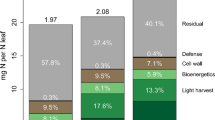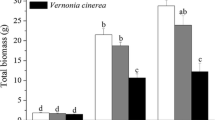Abstract
Among the mechanisms underlying biological invasions, the evolution of increased competitive ability (EICA) hypothesis, proposing that invasive plants may become superior competitors in their introduced ranges because they are able to reduce resource allocation to defenses while increasing allocation to growth in response to low herbivory, is one of the most common explanations for the success of invasive plants because EICA is a mechanism added to other mechanisms currently well known in invasion biology such as enemy release hypothesis (ERH), genetic admixture and propagule pressure and so on. Nitrogen is a primary resource limiting the growth of plants. In this study, we investigated nitrogen allocation to the photosynthetic protein Rubisco and to cell walls in invasive and native tall form Spartina alterniflora to explore the mechanisms behind its successful invasion. We conducted an experiment with seeds from three populations collected respectively from its introduced range in Jiangsu Province, China, and from its native range in Georgia, USA. Seeds were germinated, and plants from all populations were grown in a greenhouse at low and high levels of nitrogen for several months. We found an increased allocation of leaf nitrogen to Rubisco of invasive tall form S. alterniflora relative to its native conspecifics in the limited nitrogen condition. Nitrogen addition had significant effect on leaf nitrogen allocation in Rubisco and cell walls of native S. alterniflora, but did not influence those of invasive populations. Invasive S. alterniflora had higher Rubisco content and photosynthetic rate than native S. alterniflora in both nitrogen treatments, but no significant differences were found in cell wall content, fraction of leaf nitrogen in cell walls and photosynthetic nitrogen use efficiency. The increased photosynthetic capacity of invaders relative to native plants resulted from the significantly higher fraction of nitrogen allocated to Rubisco and higher nitrogen content in the low nitrogen treatment, but only higher nitrogen content in the high nitrogen treatment. Our results suggest that shifts in these leaf traits following its introduction to a new range may play an important role in invasion success of tall form S. alterniflora.


Similar content being viewed by others
References
An SQ, Gu BH, Zhou CF, Wang ZS, Deng ZF, Zhi YB (2007) Spartina invasion in China: implications for invasive species management and future research. Weed Res 47:383–391
Berger JJ, Witkin J, Coulton D (1990) Ecological restoration in the San Francisco Bay Area. Restoring the Earth. Berkeley, California
Blossey B, Nötzold R (1995) Evolution of increased competitive ability in invasive nonindigenous plants: a hypothesis. J Ecol 83:887–889
Bowes G, Ogren WL, Hageman RH (1972) Light saturation, photosynthesis rate, RuBP carboxylase activity, and specific leaf weight in soybeans grown under different light intensities. Crop Sci 12:77–79
Callaway JC, Josselyn MN (1992) The introduction and spread of smooth cordgrass (Spartina alterniflora) in South San Francisco Bay. Estuaries 15:218–226
Cheng L, Fuchigami L (2000) Rubisco activation state decreases with increasing nitrogen content in apple leaves. J Exp Bot 51:1687–1694
Chung CH, Zhuo RZ, Xu GW (2004) Creation of Spartina plantations for reclaiming Dongtai, China, tidal flats and offshore sands. Ecol Eng 23:135–150
Coley PD (1983) Herbivory and defensive characteristics of tree species in a low land tropical forest. Ecol Monogr 53:209–233
Daehler CC, Strong DR (1996) Status, prediction and prevention of introduced cordgrass Spartina spp. invasions in Pacific estuaries, USA. Biol Conserv 78:51–58
Deng ZF, An SQ, Zhou CF, Wang ZS, Zhi YB, Wang Y, Shi SH, Chen L, Zhao C (2007) Genetic structure and habitat selection of the tall form Spartina alterniflora Loisel. in China. Hydrobiologia 583:195–204
Denno RF, Peterson MA, Gratton C, Cheng J, Langellotto GA, Huberty AF, Finke DL (2000) Feeding-induced changes in plant quality mediate interspecific competition between sap-feeding herbivores. Ecology 81:1814–1827
Eichelmann H, Laisk A (1999) Ribulose-1,5-bisphosphate carboxylase/oxygenase content, assimilatory charge, and mesophyll conductance in leaves. Plant Physiol 119:179–189
Evans JR (1989) Photosynthesis and nitrogen relationship in leaves of C3 plants. Oecologia 78:9–19
Feng YL, Lei YB, Wang RF, Callaway RM, Valiente-Banuet A, Inderjitd, Li YP, Zheng YL (2009) Evolutionary tradeoffs for nitrogen allocation to photosynthesis versus cell walls in an invasive plant. Proc Natl Acad Sci USA 106:1853–1856
Field C, Mooney HA (1986) The photosynthesis–nitrogen relationship in wild plants. In: Givnish T (ed) On the economy of form and function. Cambridge University Press, Cambridge, pp 22–55
Goodger JQD, Gleadow RM, Woodrow IE (2006) Growth cost and ontogenetic expression patterns of defence in cyanogenic Eucalyptus spp. Trees Struct Funct 20:757–765
Hikosaka K, Hanba YT, Hirose T, Terashima I (1998) Photosynthetic nitrogen-use efficiency in leaves of woody and herbaceous species. Funct Ecol 12:896–905
Hoft M, Verpoorte R, Beck E (1996) Growth and alkaloid contents in leaves of Tabernaemontana pachysiphon Stapt (Apocynaceae) as influenced by light intensity, water and nutrient supply. Oecologia 107:160–169
Johnson DS, Jessen BJ (2008) Do spur-throated grasshoppers, Melanoplus spp. (Orthoptera: Acrididae), exert top-down control on smooth cordgrass Spartina alterniflora in northern New England? Estuar Coasts 31:912–919
Lamport DTA (1965) The protein component of primary cell walls. Adv Bot Res 2:151–218
Li B, Liao CH, Zhang XD, Chen HL, Wang Q, Chen ZY, Gan XJ, Wu JH, Zhao B, Ma ZJ, Cheng XL, Jiang LF, Chen JK (2009) Spartina alterniflora invasions in the Yangtze River estuary, China: an overview of current status and ecosystem effects. Ecol Eng 35:511–520
Makino A, Osmond B (1991) Effects of nitrogen nutrition on nitrogen partitioning between chloroplasts and mitochondria in pea and wheat. Plant Physiol 96:355–362
Makino A, Mae T, Ohira K (1986) Colorimetric measurement of protein stained with Coomassie Brilliant Blue R on sodium dodecyl sulfate-polyacrylamide gel electrophoresis by Eluting with Formamide. Agric Biol Chern 50:1911–1912
Normile D (2004) Expanding trade with China creates ecological backlash. Science 306:968–969
Onoda Y, Hikosaka K, Hirose T (2004) Allocation of nitrogen to cell walls decreases photosynthetic nitrogen-use efficiency. Funct Ecol 18:419–425
Pattison RR, Goldstein G, Ares A (1998) Growth, biomass allocation and photosynthesis of invasive and native Hawaiian rainforest species. Oecologia 117:449–459
Pennings SC, Bertness MD (2001) Salt marsh communities. In: Bertness MD, Gaines SD, Hay ME (eds) Marine community ecology. Sinauer, Sunderland, pp 289–316
Poorter H, Evans JR (1998) Photosynthetic nitrogen-use efficiency of species that differ inherently in specific leaf area. Oecologia 116:26–37
Qin P, Jin MD, Xie M (1985) The comparison of community biomass among the three eotypes of Spartina alternifora on the beach of estuary Luoyuan Bay, Fujian. J Nanjing Univ (Research Advances in Spartina-Achievements of Past 22 Years):226–236
Qing H, Yao YH, Xiao Y, Hu FQ, Sun YX, Zhou CF, An SQ (2011) Invasive and native tall forms of Spartina alterniflora respond differently to nitrogen availability. Acta Oecol 37:23–30
Silliman BR, Bortolus A (2003) Underestimation of Spartina productivity in western Atlantic marshes: marsh invertebrates eat more than just detritus. Oikos 101:549–554
Silliman BR, Zieman JC (2001) Top-down control of Spartina alterniflora production by periwinkle grazing in a Virginia salt marsh. Ecology 82:2830–2845
Travis SE, Proffitt CE, Lowenfeld RC, Mitchell TM (2002) A comparative assessment of genetic diversity among differently-aged populations of Spartina alterniflora on restored versus natural wetlands. Restor Ecol 10:37–42
von Caemmerer S (2000) Biochemical models of leaf photosynthesis. Csiro Publishing, Collingwood
Wareing PF, Khalifa MM, Teharne KJ (1968) Rate limiting processes in photosynthesis at saturating light intensities. Nature 220:453–457
Warren CR, Adams MA (2001) Distribution of N, Rubisco and photosynthesis in Pinus pinaster and acclimation to light. Plant, Cell Environ 24:599–612
Warren CR, Dreyer E, Adams MA (2003) Photosynthesis-Rubisco relationships in foliage of Pinus sylvestris in response to nitrogen supply and the proposed role of Rubisco and amino acids as nitrogen stores. Trees 17:359–366
Wijte AHBM, Gallagher JL (1996) Effect of oxygen availability and salinity on early life history stages of salt marsh plants. I. Different germination strategies of Spartina alterniflora and Phragmites australis (Poaceae). Am J Bot 83:1337–1342
Xu GW, Zhou RZ (1985) Preliminary studies of introduced Spartina alteriflora Loisel in China. J Nanjing Univ (Research Advances in Spartina-Achievements of Past 22 Years):212–225
Xu GW, Zhou RE, Chung CH (1993) A study of effects of accelerating Dongtai coastal tideland sedimentation by Spartina alterniflora plantation. J Nanjing Univ (Second Special Issue on the Causes and Countermeasures of Natural Disasters):228–231
Zhang RS, Shen YM, Lu LY, Yan SG, Wang YH, Li JL, Zhang ZL (2004) Formation of Spartina alterniflora salt marshes on the coast of Jiangsu Province, China. Ecol Eng 23:95–105
Zheng YL, Feng YL, Liu WX, Liao ZY (2009) Growth, biomass allocation, morphology, and photosynthesis of invasive Eupatorium adenophorum and its native congeners grown at four irradiances. Plant Ecol 203:263–271
Zhou CF, An SQ, Deng ZF, Yin DQ, Zhi YB, Sun ZY, Zhao H, Zhou LX, Fang C, Qian C (2009) Sulfur storage changed by exotic Spartina alterniflora in coastal saltmarshes of China. Ecol Eng 35:536–543
Zou JW, Rogers WE, Siemann E (2007) Differences in morphological and physiological traits between native and invasive populations of Sapium sebiferum. Funct Ecol 21:721–730
Acknowledgments
This study was supported by the Special Research Program for Public-Welfare Forestry (200804005) and the Major Water Special Projects (2012ZX07529-002-03 and 2012ZX07210-005).
Author information
Authors and Affiliations
Corresponding author
Rights and permissions
About this article
Cite this article
Qing, H., Cai, Y., Xiao, Y. et al. Leaf nitrogen partition between photosynthesis and structural defense in invasive and native tall form Spartina alterniflora populations: effects of nitrogen treatments. Biol Invasions 14, 2039–2048 (2012). https://doi.org/10.1007/s10530-012-0210-4
Received:
Accepted:
Published:
Issue Date:
DOI: https://doi.org/10.1007/s10530-012-0210-4




